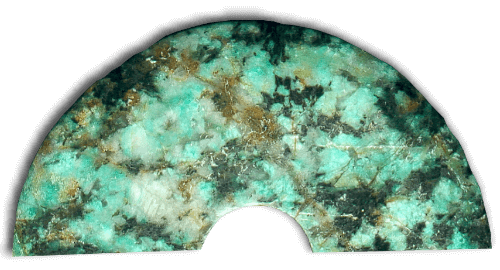
A dioritic rock intergrown with chrysocolla is often missleadingly offered as "African turquoise".
Foto: K. Sieber, www.makrogalerie.de
The finely spread, powdery mineral that gives this rock a blue-green color was offered as »African Turquoise«. As we had our doubts, X-ray diffraction (EDX) analyses have been done to determine the mineral content and the type of rock.
On the basis of the X-ray diffraction the components chlorite, kaolinite, muscovite (illite), quartz, anorthite or albite and possibly epidote and an amphibole could be identified. This mineral composition is typical for a decomposed granitic rock. The results do not provide any information about the identity of the coloring blue-green mineral. Additional thin section analysis clarified the situation.
Thin section analysis showed the mineralogical pattern und indications for a decomposed quartz-diorite in which chrysocolla has been formed mainly along fissures and crevices.
In order to definitely rule out the presence of turquoise, the element content of a small sample of the blue-green mineral was alalyzed by X-ray fluorescence (XRF) analysis. The elementary composition did not give any indication of the presence of turquoise, but showed the typical element distribution of chrysocolla.
Result
Based on the (partly relictic) mineral content, this rock could be identified as decomposed quartz-diorite - a granitic rock with a lot of quartz and feldspars. In his lifetime, this rock was penetrated by copper-bearing solutions, which promoted the decomposition process of the original minerals and at the same time led to the formation of chrysocolla.
The rock can therefore be described as decomposed (altered) chrysocolla-diorite.




